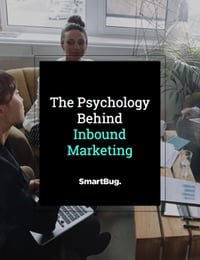
6 Writing Tricks to Combat Short Attention Spans
June 25, 2018
“Be a writer first and marketer second.”
Ann Handley, head of content at MarketingProfs, shared this idea in a recent webinar I attended, and it’s one that's all too forgotten by marketers.
Too many times, businesses tout their products and services—chock-full of industry jargon and terms that most people have no clue about—in an attempt to “sell” the user.
But if the words used are unable to grab and keep the user’s attention, are those truly the “right words” to use?
The goal with any marketing activity is to get someone to take action. Whether you want someone to click on your email, fill out a form, or contact you directly—the words you use matter and you must be able to relate to people.
Given that humans now have the attention span of a goldfish, what are some tips you should remember as you write and publish content? Here are a few:
1) Lighten Up: Use “Talk” Instead of “Converse”
Web content should be easy to read and have a conversational tone with readers. Using unnecessary or uncommon words doesn’t help you resonate with your audience—it alienates them—and you should avoid using them.
This is why throwing industry jargon or “branded” terms on your products and service pages isn’t a good idea. Instead, you should be telling stories about how people use your product or service, how it helps them solve everyday problems, and how it improves their life and work.
2) Use the Return Button Often and Write in Short Sentences
To keep the attention of your readers, your content should be clearly formatted and easy to read. One of the most effective ways to accomplish this is to use the return/enter button every two to three sentences as you write.
Big walls of text are overwhelming to readers, and it makes people feel like they’ll have to read everything to understand your message.
Think about the last time you received a lengthy text message. If you’re anything like me, you probably got overwhelmed just looking at it!
So make sure you’re spacing out your words and writing in clear, short sentences; this will make for a better user experience and give you the best chance to keep the attention of your reader.
3) Use Coherence Markers
Coherence markers include prepositions and other transition words/phrases that are used to help connect ideas: words like but, as, so, etc.
It turns out these words can add clarity and actually boost persuasion in readers.
Below is an example of two ads from Dove—one that uses coherence markers and one that doesn’t.
Dove Soft-Touch Ad #1
Your skin’s natural oils keep it silky and supple. As you age, it becomes less elastic and the production of oil slows down. Aging can cause dull, dehydrated skin. It’s essential to replenish the lost moisture with a natural, soothing alternative. Dove leaves your body clean and smooth. It contains ten times more natural oil than regular shower gels.
Dove Soft-Touch Ad #2
Your skin’s natural oils keep it silky and supple. But as you age, your skin becomes less elastic and the production of oil slows down. That is why aging can cause dull, dehydrated skin. So it’s essential to replenish the lost moisture with a natural, soothing alternative. Dove leaves your body clean and smooth, because Dove contains ten times more natural oil than regular shower gels.
So as you write, make sure to use coherence markets and other psychological triggers to add clarity and keep the attention of your readers.
4) Tell a Story and Use Conflict
Every story has a beginning, middle and end—and no story is ever complete without conflict.
As you draft copy for landing pages, blogs, emails, etc., you want to make sure you’re illustrating a conflict and how your product/service helps resolve that issue.
Here’s an example of how you can create conflict on a landing page:
Situation: Too many salespeople from company X were leaving before completing their 12-month sales training program.
Conflict/Complication: In fact, the issue was so bad that it cost company X over $50,000 just to recruit and replace the employees who left.
So he called Superior Sales Training.
Resolution: Superior Sales Training helped cut Company X’s sales training program to six weeks, drastically reducing onboarding time and allowing employees to jump right into the field.
Think about the best TV shows, movies, or books you’ve ever seen and read; there is always conflict. And it’s the conflict (and resolution) that keeps us engaged and entertained.
5) Be Authentic and Transparent
Businesses are ever focused on driving leads and customers. But before you can turn a prospect into a customer, you first need to earn their trust.
So how can you gain trust through your content? It starts with being transparent about your company, its goals, and why you’re in business in the first place. Share your experiences and why you began helping people, and don’t be afraid to address any shortcomings you may have dealt with.
Wells Fargo, Uber, and Facebook have all recently faced backlash for how they’ve dealt with internal crises, and all three have now released ads to try to earn back the trust of users.
At the end of the day, consumers need to trust you. So be authentic and honest in your writing.
Here are a few tips that can help you relate to people as you write:
- Write in the 2nd person (you should)
- Use common pain points and experiences that people are familiar with
- Use simple words (see above, “talk vs. converse”)
- Avoid using too many industry terms/jargon (remember that you can’t change how people talk, but you can change how they think)
6) Format Your Posts
In addition to avoiding long paragraphs and writing in short sentences, there are a few other tips you should follow as you’re formatting content.
To make your content easily readable, you should:
- Use bulleted lists or numbers when possible
- Use subheaders to clearly label what the next section/paragraph is about
- Bold important text and phrases, but use it sparingly
- Always end with a summary or a call to action telling the user what they should do next
Keeping your content cleanly formatted will help you maintain the attention of your readers. So take a few minutes before you publish your next landing page, blog, or email, and ensure that readers—at a quick glance—can see exactly what you’re trying to communicate.
Summary
The internet is filled with content, and it’s only going to get more cluttered when you consider the fact that 90% of the content available has been created in the last two to three years alone.
As more and more content is added to the internet each day, you need to make sure your content isn’t getting lost in the shuffle.
By keeping these tips in mind as you publish, you can be confident knowing that you’re giving your content the best possible chance to perform.

About the author
Christopher Hutchens was formerly an E-commerce Marketing Strategist at SmartBug Media based in Salt Lake City. Originally from Chicago, Chris graduated from Mizzou and worked in Columbia, Missouri as an interactive project manager for five years before coming to SmartBug. Outside of work, Chris loves to travel, snowboard, and play/watch basketball. Read more articles by Christopher Hutchens.







